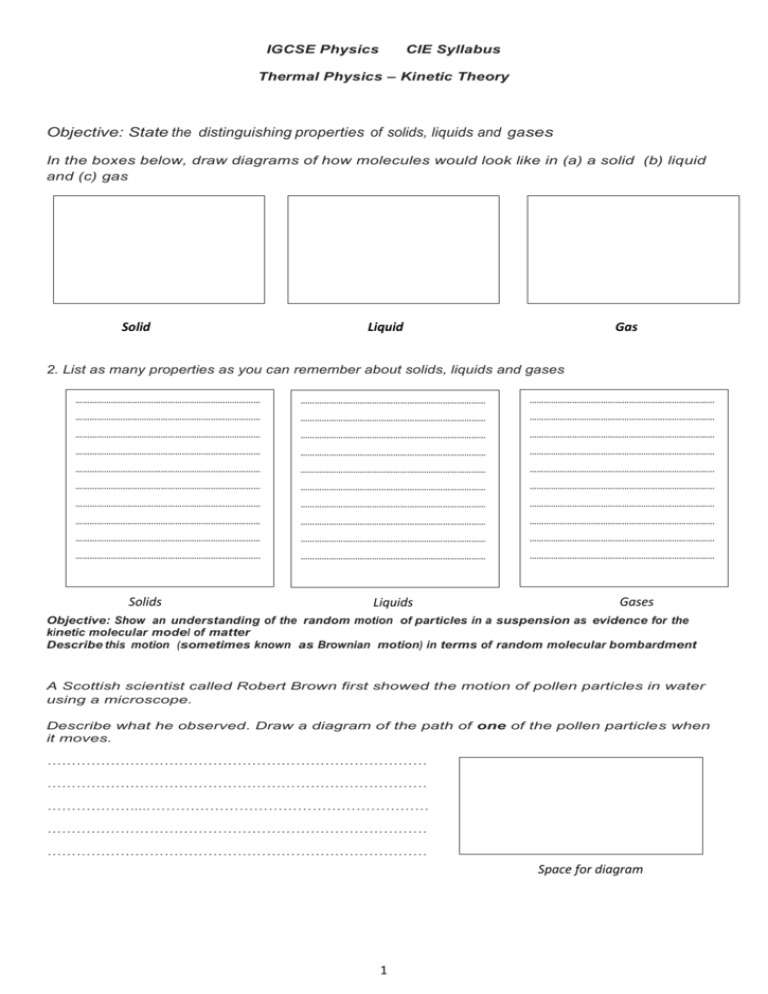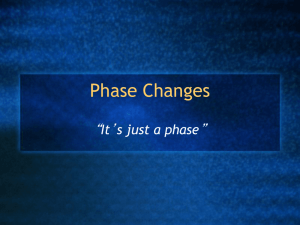IGCSE Physics CIE Syllabus Thermal Physics – Kinetic Theory
advertisement

IGCSE Physics CIE Syllabus Thermal Physics – Kinetic Theory Objective: State the distinguishing properties of solids, liquids and gases In the boxes below, draw diagrams of how molecules would look like in (a) a solid (b) liquid and (c) gas Solid Liquid Gas 2. List as many properties as you can remember about solids, liquids and gases …………………………………………………………………… …………………………………………………………………… …………………………………………………………………… …………………………………………………………………… …………………………………………………………………… …………………………………………………………………… …………………………………………………………………… …………………………………………………………………… …………………………………………………………………… …………………………………………………………………… …………………………………………………………………… …………………………………………………………………… …………………………………………………………………… …………………………………………………………………… …………………………………………………………………… …………………………………………………………………… …………………………………………………………………… …………………………………………………………………… …………………………………………………………………… …………………………………………………………………… …………………………………………………………………… …………………………………………………………………… …………………………………………………………………… …………………………………………………………………… …………………………………………………………………… …………………………………………………………………… …………………………………………………………………… …………………………………………………………………… …………………………………………………………………… …………………………………………………………………… Solids Liquids Gases Objective: Show an understanding of the random motion of particles in a suspension as evidence for the kinetic molecular model of matter Describe this motion (sometimes known as Brownian motion) in terms of random molecular bombardment A Scottish scientist called Robert Brown first showed the motion of pollen particles in water using a microscope. Describe what he observed. Draw a diagram of the path of one of the pollen particles when it moves. …………………………………………………………………… …………………………………………………………………… ………………....………………………………………………… …………………………………………………………………… …………………………………………………………………… Space for diagram 1 Modern day ‘Brownian Motion’ is seen in a smoke cell. It is a small glass box with one side open. It is filled with smoke from the bottom end of a burning straw, and closed quickly with a thin glass lid such as a microscope slide. The box is illuminated from one side, and viewed at a perpendicular direction with a microscope at low power such as ‘x 10 ‘ . It is focussed to the middle of the box. Smoke particles, suspended in air, are much more massive than air particles and are seen as bright specks of light in the microscope’s field of view. They move haphazardly, without any order in zig-zag paths of variable lengths. (Imagine following the front foot of a drunkard walking!) The diagram below illustrates this. Explain, using a diagram why the smoke particles move the way they do. Use the words ’invisible’, ‘air particles’ ‘bombard’, ‘momentum’, ‘resultant force’, ‘speed’ …………………………………………………………………………………………… …………………………………………………………………………………………… …………………………………………………………………………………………… …………………………………………………………………………………………… …………………………………………………………………………………………… …………………………………………………………………………………………… …………………………………………………………………………………………… …………………………………………………………………………………………… …………………………………………………………………………………………… ………………………………………………………………….……………………… Space for diagram Typical path of one smoke particle in smoke cell Objective • Interpret the temperature of a gas in terms of the motion of its molecules • Describe qualitatively the pressure of a gas in terms of the motion of its molecules • Describe qualitatively the effect of a change of temperature on the pressure of a gas at constant volume Brownian motion established the fact that 1. A gas is made up of very small particles, which were given the name ‘molecules’. 2. The molecules of a gas move endlessly and randomly, in all directions, with all speeds. 3. The molecules collide elastically, amongst themselves and with the walls of the container. 1, 2, and 3 above form part of a particular theory in Physics. What is the name of this theory? Choose one from below: A. Brown’s Theory B. Theory of nature C. Kinetic theory D. Gas theory The molecules of a gas are always in motion, so they have kinetic energy. If there are N molecules (N is of the order of 1023 (Avagadro’s number = 6 x 1023 = the no.of particles in one mole) or more. We can define average k.e. per molecule as K.E. ave = < Ek > = (Sum of k.e. of all molecules) ÷ N 2 Now imagine heating a gas in a container. The heat energy goes to the particles, which are already moving. The temperature of the gas increases. What change will take place to the molecules’ motion? A. Move faster B. Move slower C. Move in circles D. No change What change will take place to the average kinetic energy per molecule of the gas? A. Decreases decreases B. Increases C. Does not change D. Increases, then If we want to relate temperature of a gas (or in fact matter in any state) to molecular properties, which quantity would you recommend? A. Mass B. Size C. Colour D. < Ek > In fact the absolute temperature of a gas is defined as a quantity proportional to the average molecular kinetic energy! When we study pressure due to solids or liquids we define pressure as force per unit area (p = F/A). Remember, solids transmit force instantly. Liquids transmit pressure instantly. Here we have clearly recognizable force and area. In a gas, this is less obvious. A gas cannot transmit pressure instantly. Imagine pushing the handle of this pump down with the air hole at the end closed with your thumb. You can feel the pressure from the air. The air is pushing with a force. Like your thumb, the walls of the pump also experience force. Let us represent this pump with a simple box. Remember, there are like 1025 molecules all moving chaotically everywhere. Some are shown here. Average mass of an air particle is 6 x 10-26 kg, and typical speed of an air particle is 500m/s! 1. Molecule X is travelling as shown. It has a momentum. Wall AB will ‘feel’ a force when X hits it. Why? A ……………………………………………………………………………… X ………………………………………………………………………………. m Putting together all these tiny forces due the huge number of molecules , what would you expect for the overall effect? ……………………………………………………………………………… B ……………………………………………………………………………… The pressure of a gas in a container is due to the combined effect (force) due to the bombardment of a large number of molecules on the walls. The more frequent these bombardments are, the greater the pressure. We can say: Pressure is proportional to collision frequency. Now imagine heating a gas in a closed container which itself does not expand due to heating. What change will happen to the force exerted by the molecules? …………………………………………………………………………………………………………………………………………………………………………… How will the pressure change? …………………………………………………………………………………………………………………………………………………………………………… 3 Now imagine a gas in a cylinder with a piston as shown below: Pressure – Volume Relationship Suppose the temperature T is always kept the same, i.e. the gas is heated if temperature drops below the set value or cooled if it gets warmer. The piston is pushed to the right and held , making less space for the molecules to move about. Remember, the average k.e. per molecule is still the same, as T is constant. Weight What do you expect to happen to (a) the speed of the molecules? A. Same as before B. Greater C. Less (b) the number of collisions per second with the walls? A. Same as before B. Greater C. Less (c ) the pressure on the walls of the cylinder A. Same as before B. Greater C. Less The diagram on the left helps illustrate simply the consequences of changing one of (a) temperature, T (b) pressure, p (c) number N of molecules in a cylinder of gas, when all others are kept the same. Suppose the weight of the piston is so small compared to the weight in the tray, so the weight represents pressure. Length l represents volume. Suppose the piston is in equilibrium to start with. Some changes are made as seen below. Choose one of A. Up or B. Down as your answer to the following questions: Piston How will the piston move when (a) the cylinder is heated to a higher temperature? ………………………………………… At constant pressure, volume is directly proportional to the absolute temperature. Gas l (b) More weights are added, so that the pressure is increased? ……………..………… At constant temperature, volume is inversely proportional to the pressure. (c) More gas is allowed in at the same temperature and pressure? ………………… Heat At constant temperature and pressure, volume is directly proportional to the number of molecules. In the following, the piston does not move. (d) The gas is heated, but is not allowed to expand. What change has to be made to the weights to keep the volume the same? A. Increased B. Decreased At constant volume , pressure is directly proportional to the absolute temperature. The four statements in (a), (b), (c) and (d) can be combined into one compact equation pV = nRT which is called the ideal (or perfect) gas equation. n is the number of moles of gas and R is the universal gas constant. 4






